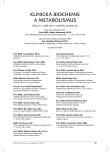Comparison of Measurement Free Light Chains by SPAPLUS and Immage 80
Authors:
K. Bořecká 1; P. Sečník 2,3; A. Jabor 2,3; J. Granátová 1; M. Bolková 1
Authors‘ workplace:
Oddělení klinické biochemie, Thomayerova nemocnice, Praha
1; Pracoviště laboratorních metod, IKEM, Praha
2; 3. lékařská fakulta UK, Praha
3
Published in:
Klin. Biochem. Metab., 25, 2017, No. 3, p. 112-115
Overview
Objective:
Comparison of turbidimetric measurement of FLC concentrations by SpaPLUS (The Binding Site) and Immage 800 (Beckman Coulter), including index κ/λ, was the aim of this experiment.
Design:
Settings:
Department of Clinical Biochemistry, Thomayer’s Hospital and Institute for Clinical and Experimental Medicine, Prague
Materials and Methods:
We simultaneously measured FLC-κ and FLC-λ concentrations in serum samples (n = 73) by Immage 800 and SpaPLUS. We chose non-haemolytic samples with different FLC concentration, both from healthy probands, and from patients with MGUS (Monoclonal Gammopathy of Undetermined Significance) and MM (Multiple Myeloma). We calculated index κ/λ and statistically processed results. We also measured FLC concentration in control samples and assessed repeatability and intermediate precision.
Results:
We found significant difference for FLC-κ, FLC-λ, and κ/λ ratio. Concentrations measured by Immage 800 were generally lower in all parameters in comparison with SpaPLUS. FLC-κ difference was more pronounced than FLC-λ difference. Minority of samples (n = 15), predominantly with high concentrations of FLC-κ, showed inversed trend and FLC-κ results were clearly higher when measured on Immage 800. Measurement precision (CV%) was slightly different in comparison to manufacturer’s data, nevertheless satisfactory for clinical purposes.
Conclusion:
Although we confirmed the expected difference of values measured by different devices, we do not consider the difference clinically relevant. We observed the shift in interpretation of κ/λ ratio using standard reference range (pathological value of κ/λ on the first analyzer, and κ/λ in reference range on second analyzer when measuring identical sample) only in limited number of cases.
Keywords:
Free Light Chains (FLC), κ/λ ratio, monoclonal gammopathy, turbidimetry.
Sources
1. Špička, I. et al. Mnohočetný myelom a další mono-klonální gamapatie. Praha: Galén, 2005, 128 s. ISBN 8072623303.
2. Šumná, E., Nováčková, L., Martínek, A., Ščudla, V. Význam hodnocení sérových hladin volných lehkých řetězců imunoglobulinů u monoklonálních gamapatií. Interní Med., 2006, 8 (11), p. 502 - 504.
3. Ščudla, V., Vytřasová, M., Minařík, J. et al. Klinický význam hodnocení sérových hladin volných lehkých řetězců imunoglobulinů u monoklonálních gamapatií. Trans Hemat dnes, 2005, 2, p. 47 - 53.
4. Bradwell, A. R., Carr-Smith, H. D., Mead, G. P., Drayson, M. T. Serum free light Chain immunoassays and their clinical application. Clin. Applied Immunol. Rev., 2002, 3, p. 17 - 33.
5. Bradwell, A. R., Mead, G. P., Carr-Smith, H. D. Serum free light Chain analysis (plus Hevylite). 6th Edition Birmingham, The Binding Site Ltd., 2010.
6. Drayson, M. T., Tang, L. X., Drew, R., Mead, G. P., Carr-Smitth, H. D., Bradwell, A. R. Serum free light-chain measurements for identifying and monitoring patiens with nonsecretory multiple myeloma. Blood, 2001, 97 (9), p. 2900 - 2902.
7. Gupta, S., Comenzo, R. L., Hoffman, B. R., et al. National Academy of Clinical Biochemistry Guidelines for the Use of Tumour Markers in Monoclonal Gammopathies. NACB LMPG, 2006, www.nacb.org.
8. Dispenzieri, A., Kyle, R., Merlini, J. S. et al. International Myeloma Working Group guidelines for serum free-light chain analysis in multiple myeloma and related disorders. Leukemia, 2009, 23 (2), p. 215 - 224.
9. Ščudla, V., Minařík, J., Schneiderka, P., et al. Význam sérových hladin monoklonálních volných lehkých řetězců imunoglobulinu v diagnostice a hodnocení aktivity mnohočetného myelomu a vybraných monoklonálních gamapatií. Vnitř. Lék., 2005, 51, p. 1249 - 1259.
10. Lachmann, H. J., Gallimore, R., Gilmore, J. D. et al. Outcome in systemic free immunoglobulin light chains following chemotherapy. Brit. J Haematol, 2003, 122 (1), p. 78 - 84.
11. Hutchison, C. A., Plant, T., Drayson, M. et al. Serum free light chain measurement aids the diagnosis of myeloma in patients with severe renal failure. BMC Nephrol., 2008, 9(11), http://doi.org/10.1186/1471-2369-9-11.
12. Tichý, M., Vávrová, J., Friedecký, B., Maisnar, V. Přehled metod na stanovení volných lehkých řetězců. Klin. Biochem. Metab., 16 (37), 2008, No. 2, p. 93 - 96.
13. Vávrová, J., Tichý, M., Friedecký, B. et al. Mezilaboratorní studie stanovení volných monoklonálních lehkých řetězců imunoglobulinů. Klin. Biochem. Metab., 18 (39), 2010, No. 2, p. 73 - 76.
14. Tate, J., Bazeley, S., Sykes, S., Mollee, P. Quantitative serum free light chain assay – analytical issues. Clin Biochem Rev., 30 (3), 2009, p. 131 - 140.
15. příbalové letáky souprav.
Labels
Clinical biochemistry Nuclear medicine Nutritive therapistArticle was published in
Clinical Biochemistry and Metabolism

2017 Issue 3
Most read in this issue
- „Normal“ laboratory finding
- Therapeutic monoclonal antibodies in clinical laboratory
- Congenital disorders of glycosylation: alpha-dystroglycanopathies
- Determination of albumin in serum and plasma. Harmonization of results and clinical recommendations in patients with renal diseases.
